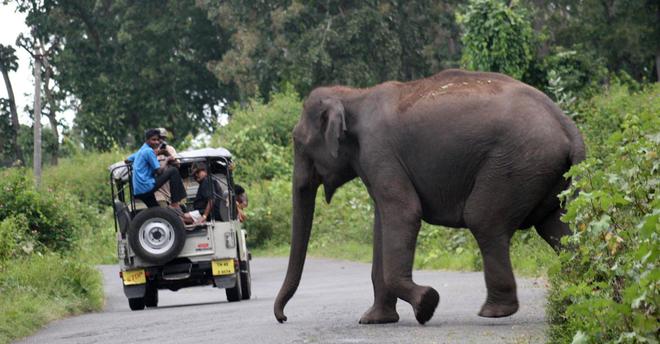Last week, a six-year-old elephant in the Mudumalai Tiger Reserve in the Nilgiris was found lying weak and exhausted in a private property, possibly due to the lack of green fodder and severe heat in the hills this year. Reminiscent of 2017, when a number of elephants died of thirst and starvation, 2024 too is set to be a challenging year for wildlife and conservation in the Western Ghats.
The hills of South India are expected to be a source of refuge for people trying to escape the heatwaves in the cities. Conservationists and experts working in the ecologically fragile Western Ghats have sounded the alarm over the expected surge in tourists to the mountains this year, stating that the increased pressures of tourism, combined with extreme weather, could have a wide-scale environmental impact on local ecosystems. For instance, storage levels in key drinking water sources in the Nilgiris, such as at Parsons Valley and Marlimund, are at 34% and 21% of their total capacities as of April 6.
Kodaikanal | The hills are (barely) alive
Vasanth Bosco, a restoration ecologist and founder of Upstream Ecology, says that hotter summers in the hills lead to the spread of more invasive species such as Lantana camara and Eupatorium, and also to lesser availability of food for wildlife due to grazing pressures from cattle. “We are already witnessing higher human-animal conflict rates in parts of the Nilgiris such as Gudalur, as water becomes scarce. Tourism will only exacerbate the crisis,” he adds.

Larger issues
An analysis of the temperature trends in Udhagamandalam by the Indian Institute of Soil and Water Conservation, with temperature data between 1960 and 2018, revealed that the frequency of ‘warmer years’ increased from 1990 to 2018. “The annual mean maximum temperature above 20° Celsius between 1960 and 1989 was recorded only twice, while the mean maximum temperature above the 20°C threshold was breached 10 times since 1990,” said a researcher who analysed the data.
Shobana Chandrashekar, a member of the ‘Make Ooty Beautiful’ project, who has been pushing for a more sustainable tourism model in the Nilgiris and the Western Ghats, said that there needs to be a cap on tourist numbers to the hills, especially during drought years.
In March, the Madras High Court had requested the Advocate General of Tamil Nadu to convene a meeting with the secretaries of municipal administration, forest and tourism departments to fix a carrying capacity for the ghat roads leading to the Nilgiris and Kodaikanal, which was agreed to in-principal by the State government.
What our cities need: a master plan
However, Suprabha Seshan, conservationist and long-term custodian of the Gurukula Botanical Sanctuary in Wayanad, says that tourism is only the “tip of the iceberg”. She believes the rising number of human-animal conflicts in Wayanad to be a result of of urbanisation and fragmented forest cover. “Small farmers who may feel the need to sell their properties for housing or resorts can be financially incentivised to nurture biodiversity,” Seshan says.
Understanding the forests
The hills of Coorg too are witnessing severe stresses due to tourism, adds Aparna Kumar, a member of Clean Coorg. “Unlike the Himalayas, Coorg and its rivers, including the Cauvery, are completely rain-fed.” Kumar says that conversion of what were previously agricultural lands into housing plots and resorts is threatening water security and local ecology. “Bengaluru’s rapid expansion at the cost of its lakes and tanks has led to the problems it currently faces. Tourism is bringing the same issues to Coorg and other hill regions,” she says.
Yercaud in Tamil Nadu has also witnessed a surge in tourists, particularly from Chennai and Bengaluru, in recent weeks. N. Moinudheen, an independent researcher and wildlife biologist, says that forest fires have increased due to discarding of cigarettes in forest areas. “Each fire takes a minimum of one week to put out, and threatens grasslands which are home to critically endangered species of small mammals and birds,” he states.
Experiential tourism that fosters a deeper understanding between visitors to the forests and local communities needs to be explored, says Moinudheen, if the “character” of tourism is to change. The government should look into establishing mechanisms whereby wildlife biologists are allowed to be employed or given clearance to work in specified areas, to raise awareness among the public about local biodiversity, and the impact of human activities on local environments. “People who visit these places should leave with a greater sense of urgency to protect their own green spaces back home,” he says.
These 10 new travel books are a wonderful way to immerse yourself in a destination
Journalist M. Mohan, a resident of Valparai, another popular hill station in the Western Ghats, around 100 km from Coimbatore, says that the ongoing summer is the hottest period ever undergone in the region. “Vaparai received sporadic summer showers even in 2023. But this year, it has rained only once so far, for just half an hour,” he says.
T.R. Shankar Raman, wildlife scientist with the Nature Conservation Foundation (NCF) stationed at Valparai, says that climate change is increasing extreme weather events such as severe storms. “There is a serious risk to human life and the environment from excessive construction on the steep slopes in Valparai town. Road widening, scraping of slopes and concretisation increase risk of landslides and act as heat traps leading to damage and desiccation of nearby forest vegetation,” he says.
According to him, data from other areas indicates forest trees and many wildlife species are succumbing to heat stress and this can lead to a decline of forests and wildlife. “We think something similar is happening in the Anaimalai Hills too and are looking into it as part of our research,” says Raman.
(With inputs from Wilson Thomas in Coimbatore)
rohan.prem@thehindu.co.in







